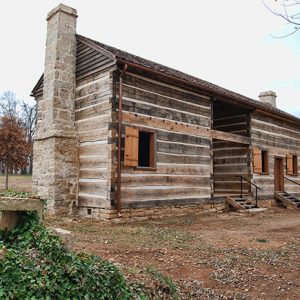calsfoundation@cals.org
William Looney Tavern
aka: Looney-French House
The William Looney Tavern stands on the west bank of the Eleven Point River near the rural community of Dalton in northwestern Randolph County. The one-and-a-half-story log structure with a central breezeway, often called “dogtrot” style, was constructed circa 1833 and is one of the finest examples of vernacular architecture in the state. Thought to have been built as a rural tavern or inn, it may have served area settler William Looney’s distillery as well. It is the only surviving structure on the farmstead Looney established prior to 1815 on land that would become Arkansas. In 1816, Looney was appointed to the first of several civil appointments he held over his lifetime. When he died in 1846, he was one of the wealthiest men in the county, with extensive land holdings, thirteen slaves, livestock, and a distillery producing apple brandy.
In the first decade following the 1803 Louisiana Purchase, William Looney (born circa 1785) and his young family arrived in the Eleven Point River valley with their few slaves. They were part of a group of immigrants who had lived as neighbors for decades in Hawkins County, Tennessee. Reuben Rice, Looney’s long-time neighbor in Tennessee, settled approximately one mile distant on the opposite side of the Eleven Point River, establishing what is today known as the Rice-Upshaw House and Site.
Looney’s arrival in the area is confirmed by the 1815 tax list for Lawrence County, and he was appointed a justice of the peace in 1816. At the first session of the Arkansas territorial legislature, held at Arkansas Post in 1820, Looney was selected to serve as a counselor should elected officials not be in place to manage governmental operations. That same year, he was appointed captain of the local militia. Before safe banking existed, he served as a local financier for men throughout the county. A few years after Randolph County was created from Lawrence County, Looney purchased the steamboat landing in Pocahontas (Randolph County).
William Looney’s house site, on land he patented in 1823, has yet to be discovered. The log dogtrot, dating to the early 1830s, was a secondary structure on the farmstead. It features exceptional original craftsmanship, including lumber sawn by hand in a saw-pit. Records support its function as a tavern/inn and possibly used for Looney’s distillery. Looney is credited with producing 1,500 gallons of apple brandy a year. Modern studies confirm that domestic occupation of the structure did not occur until the post–Civil War period.
This significant Arkansas example of early nineteenth-century log building traditions has survived only because Catherine, widow of William S. Looney (son of William) remained on the farmstead. She and her second husband, Dennis Downey, converted the structure to serve as their dwelling house. Four generations of the Downey family lived in the house until ownership passed to Jack and Christina French in the 1970s. Christina French is a direct descendant of Reuben Rice.
In 2006, the structure, listed on the National Register of Historic Places as the Looney-French House, was donated to Black River Technical College (BRTC) in Pocahontas by Jack and Christina French. Restoration of the tavern was funded through the Arkansas Natural and Cultural Resources Council. The preservation process and associated discoveries are explained by architects, archaeologists, historians, and educators through multi-media approaches both at the site and through the college’s website under the title of Project REACH—Researching Early Arkansas Cultural Heritage.
For additional information:
“Looney-French House.” National Register of Historic Places nomination form. On file at Arkansas Historic Preservation Program, Little Rock, Arkansas.
Project REACH. https://blackrivertech.edu/project-reach/ (accessed August 22, 2025).
Joan L. Gould
Fayetteville, Arkansas







Comments
No comments on this entry yet.